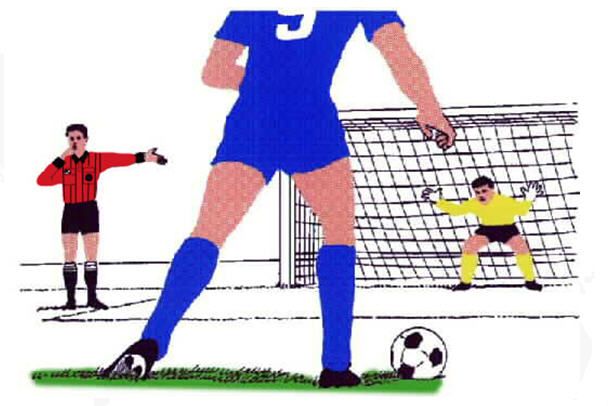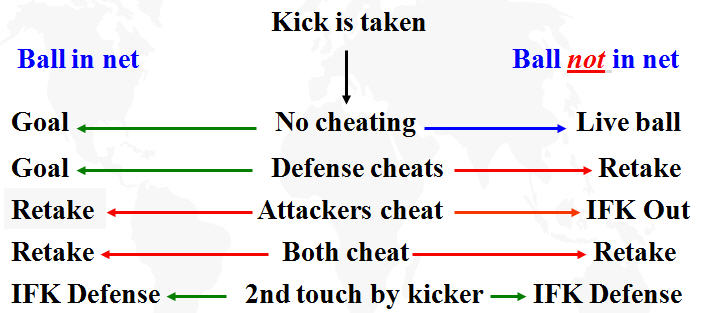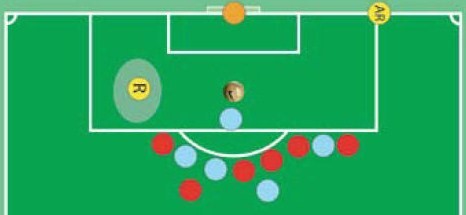Requirements of Kicker
- Kick must be taken from the mark
- Ball must be kicked forward
- Must not distract goalkeeper
- Kicker may feint, but not excessively to the point that the referee deems it unsporting behavior (yellow card caution)
- Must not "double touch" the ball

Click on this picture for a video about penalty kick mechanics
Requirements of Goalkeeper
- Must be on the goal line, between the posts, facing the field
- May not move forward from the goal line until the ball is kicked
- May move laterally (side to side)
- Must not distract the kicker

Requirements of Attackers
- Must be outside the penalty area
- Must be outside the penalty arc
- Must be laterally behind the penalty mark
- Must be on the field of play
- Must not encroach
- Must not distract the goalkeeper
Requirements of Defenders
- Must be outside the penalty area
- Must be outside the penalty arc
- Must be laterally behind the penalty mark
- Must be on the field of play
- Must not encroach
- Must not distract the kicker
The ball must be placed correctly at the penalty mark, regardless of the the state of the pitch at this location.
Moving the ball elsewhere, even with the apparent agreement of the players, is not permitted.
It is recommended that the referee inform the kick to place the ball on the penalty mark


Once the referee signals for the penalty kick, the goalkeeper may move from side to side on the goal line but may not move off the goal line (into the field or backward) until the ball has been kicked.
The requirement to be "on the goal line" is met even if one or both of the goalkeeper's feet are not physically touching the ground, so long as the goalkeeper has not moved forward or backward from the plane of the goal line

Referee
- Whistle to stop play
- Points clearly to the penalty mark and, unless needed elsewhere for game control purposes, moves to the edge of the penalty area near the goal line to discourage confrontation and dissent
- Deals with players who may attempt to protest or dispute the decision
- Intervenes quickly and decisively to prevent and deal with players who attempt to engage an assistant referee in debate regarding the penalty kick decision
- Supervises the placement of the ball
- Indentifies the kicker
- Moves to the recommended position (see diagram below)
- When the ball and all the players are properly in position, signals for the kick to be taken
- If a goal is scored, backpedals quickly up field keeping the area in front of the goal and other players under observation
- If a goal is not scored, quickly takes a position appropriate for restart or next play of the ball

Lead Assistant Referee
- Waits for the referee to begin supervising the restart and then moves to the recommended position (see diagram below) to prepare for the duties assigned by the referee in the pregame conference
- If a goal is scored, keeps players under observation and follows the normal goal procedure
- If play continues, quickly resumes the position to judge offside (cutting the corner of the field if necessary) and keeps play in view
Trail Assistant Referee
- Moves to near the midfield line and monitors player activities out of the view of the referee
- If a goal is not scored, quickly takes a position appropriate for the next phase of play
| Penalty Kick Indicated by the Assistant Referee | |
|
Referee
|
Assistant Referee
|
 |
|